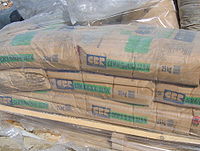
Photo from wikipedia
This paper describes the use of agricultural wastes for the preparation of carboxymethylcellulose (CMC) with a high degree of substitution using two methods: the classic and a microwave-assisted method. A… Click to show full abstract
This paper describes the use of agricultural wastes for the preparation of carboxymethylcellulose (CMC) with a high degree of substitution using two methods: the classic and a microwave-assisted method. A series of CMC samples with degrees of substitution from 0.43 to 2.83 were prepared from cellulose extracted from almond shells, almond stems, and fig stems by a one-step carboxymethylation reaction. The highest degree of substitution was 2.83, which corresponded to CMC from fig stems when butanol was used as a solvent. This CMC was easily dissolved in water and thus would provide many opportunities for diverse applications. The obtained CMCs were characterized using different tools. Different CMC films were prepared using the casting method and were characterized by the determination of their mechanical properties. The obtained results can be considered promising; they demonstrate the potential of using cellulose derivatives for the production of transparent and strong films.
Journal Title: Fibers and Polymers
Year Published: 2019
Link to full text (if available)
Share on Social Media: Sign Up to like & get
recommendations!